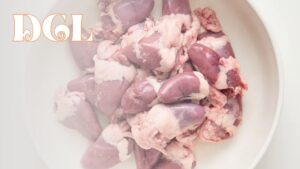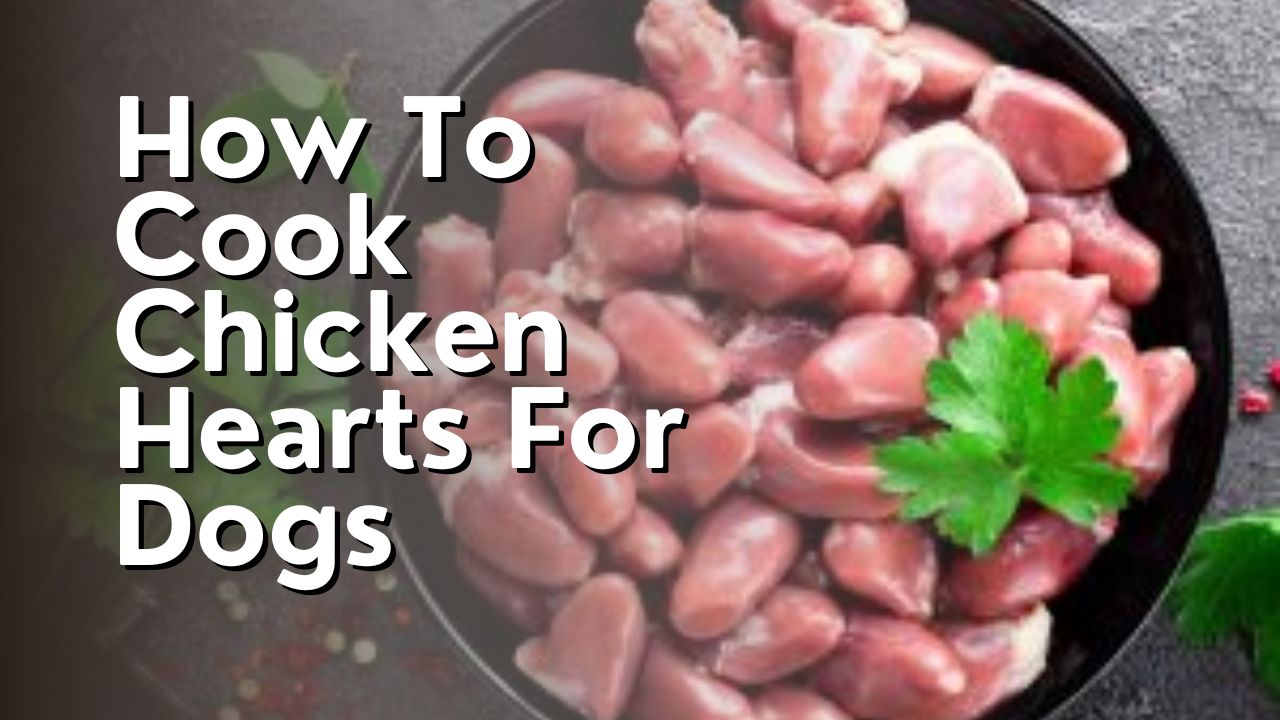If you’re a dog lover like me, you probably want to make sure your furry friend is getting the best nutrition possible. That’s why I’m here to share with you a simple guide on how to cook chicken hearts for dogs. Trust me, it’s easier than you might think!
In this article, I’ll be covering the following topics:
- The benefits of chicken hearts for dogs
- How to purchase and prepare chicken hearts
- Different cooking methods for chicken hearts
- Serving suggestions for chicken hearts
- Important safety precautions to keep in mind
By the end, you’ll have all the knowledge you need to provide your pup with a tasty and nutritious treat.
So, whether you’re looking to add some variety to your dog’s diet or you’re just curious about the benefits of chicken hearts, stick around. Let’s get started on this delicious adventure together!
The Benefits of Chicken Hearts for Dogs
Cooking chicken hearts for your furry friend not only provides them with a delicious and nutritious treat but also offers numerous benefits for their overall health and well-being.
Chicken hearts are packed with essential nutrients that can support your dog’s optimal health. They are an excellent source of protein, which is essential for muscle development and repair. Protein also helps to boost their immune system, making them less prone to illnesses.
Furthermore, chicken hearts are rich in vitamins and minerals, such as vitamin A, vitamin B12, iron, and zinc. These nutrients play a crucial role in promoting healthy skin and coat, improving digestion, and supporting proper brain function. They also contribute to strong bones and teeth, ensuring your furry friend stays active and energetic.
Another advantage of feeding chicken hearts to your dog is that they are low in fat and calories. This makes them an ideal treat for dogs who need to watch their weight or maintain a healthy weight. Additionally, the natural taurine content in chicken hearts can support heart health and prevent the development of cardiovascular diseases.
Overall, incorporating chicken hearts into your dog’s diet can provide them with a range of health benefits. Just remember to cook them thoroughly, without seasoning or additives, and offer them in moderation as part of a balanced diet. Your four-legged companion will surely appreciate this tasty and nutritious treat!

Purchasing and Preparing Chicken Hearts
When it comes to preparing a nutritious meal for your furry companion, it’s essential to carefully select and handle the vital organ that is often overlooked in traditional cooking: chicken hearts. These little powerhouses of nutrition are not only delicious but also offer several health benefits for your dog.
Chicken hearts are a great source of protein, which is essential for your dog’s muscle growth and repair. They are packed with essential vitamins and minerals like vitamin B12, iron, and zinc, which support overall health and a strong immune system. Chicken hearts are also a natural source of taurine, an amino acid that is important for heart health and can help prevent certain heart diseases in dogs.
To ensure you are getting the best quality chicken hearts for your pup, it’s important to purchase them from a reputable source. Look for fresh, organic chicken hearts to avoid any potentially harmful additives or preservatives.
When preparing them, simply rinse the hearts under cold water to remove any excess blood and pat them dry. You can then cook them by grilling, baking, or boiling them until they are fully cooked and no longer pink in the center.
Adding chicken hearts to your dog’s diet can be a nutritious and tasty way to enhance their meals. So why not give them a try and see the wagging tail of approval from your furry friend?
Cooking Methods for Chicken Hearts
Grilling, baking, or boiling are great ways to bring out the delicious flavors and maximize the nutritional benefits of these tiny nutritional powerhouses. Each cooking method has its own unique advantages and can cater to different preferences. Here, I will discuss the various cooking methods for chicken hearts and how they can be used to create a tasty and healthy meal for your furry friend.
| Cooking Method | Description |
|---|---|
| Grilling | Grilling chicken hearts gives them a smoky and charred flavor that dogs absolutely love. Simply season the hearts with a little bit of salt and pepper, then grill them on medium-high heat for about 5-7 minutes per side. Make sure to keep an eye on them to prevent overcooking and dryness. |
| Baking | Baking is a simple and convenient way to cook chicken hearts. Preheat your oven to 400°F (200°C), place the hearts on a baking sheet lined with parchment paper, and bake for 10-12 minutes. This method locks in the natural flavors and keeps the hearts moist and tender. |
| Boiling | Boiling chicken hearts is a quick and easy method that preserves their natural nutrients. Simply bring a pot of water to a boil, add the hearts, and cook for 10-15 minutes. Drain the hearts and let them cool before serving to your dog. |
Whether you prefer the smoky flavors of grilled chicken hearts, the convenience of baked hearts, or the simplicity of boiled hearts, there is a cooking method that will suit your dog’s taste buds. Experiment with different methods to find the one that your furry friend enjoys the most. Remember to always monitor the cooking process to ensure that the hearts are cooked thoroughly and safely.
Serving Suggestions and Portion Sizes
One way to enhance the dining experience for your furry friend is by exploring different serving suggestions and portion sizes for chicken hearts.
When it comes to serving chicken hearts to your dog, there are various options to consider. One suggestion is to serve them as a standalone snack or treat. You can simply cook the chicken hearts, let them cool, and then offer them to your dog as a special reward.
Another serving suggestion is to incorporate chicken hearts into your dog’s regular meals. You can chop them up and mix them with your dog’s kibble or wet food to add some extra flavor and nutrients.
When it comes to portion sizes, it’s important to consider your dog’s size and dietary needs. For smaller dogs, you may want to start with just a few chicken hearts as a treat, while larger dogs may enjoy a larger portion. As a general guideline, you can start with about 1-2 chicken hearts per 10 pounds of body weight per day. However, it’s always best to consult with your veterinarian to determine the appropriate portion size for your specific dog.
Overall, serving chicken hearts to your dog can be a tasty and nutritious addition to their diet. By exploring different serving suggestions and portion sizes, you can cater to your dog’s preferences and ensure they have a satisfying dining experience.

Safety Precautions and Considerations
To ensure a safe and enjoyable experience for your furry friend, it’s crucial to take necessary precautions and considerations when serving chicken hearts as part of their diet. Here are four important points to keep in mind:
- Sourcing: Make sure to purchase chicken hearts from reputable sources, such as trusted local butchers or pet food suppliers. This ensures that the hearts are fresh and free from any harmful additives or preservatives.
- Preparation: Thoroughly clean and rinse the chicken hearts before cooking. Remove any excess fat or connective tissues to prevent choking hazards. It’s also essential to cook the hearts thoroughly to eliminate any potential bacteria or parasites that could be harmful to your dog’s health.
- Portion Control: While chicken hearts can be a nutritious addition to your dog’s diet, it’s important to feed them in moderation. Too many hearts can lead to an imbalance in their overall nutrient intake. Consult with your veterinarian to determine the appropriate portion size based on your dog’s size, age, and dietary needs.
- Supervision: Always supervise your dog while they are eating chicken hearts or any other food. This helps prevent choking or other accidents that could harm your furry friend. If you notice any adverse reactions or digestive issues, consult your veterinarian immediately.
By following these safety precautions and considerations, you can ensure that feeding chicken hearts to your dog is a safe and enjoyable experience that contributes to their overall health and well-being.
Frequently Asked Questions
Can I feed my dog chicken hearts as a regular part of their diet?
Yes, you can feed your dog chicken hearts as a regular part of their diet. They are a great source of protein and nutrients. Just make sure to cook them properly and consult with your vet for portion sizes.
How often should I feed my dog chicken hearts?
I feed my dog chicken hearts a few times a week. They’re a great source of protein and nutrients, but it’s important to remember that they should only make up a small part of their overall diet.
Are there any potential side effects or risks associated with feeding chicken hearts to dogs?
There are potential risks associated with feeding chicken hearts to dogs. They can be high in cholesterol, which could lead to obesity or heart problems. It’s important to consult with a veterinarian before adding them to your dog’s diet.
Can chicken hearts be used as a training treat for dogs?
Chicken hearts can definitely be used as a training treat for dogs. They are small, tasty, and packed with nutrients. Just make sure to cut them into small pieces and use them in moderation as part of a balanced diet.
Can I freeze chicken hearts to use at a later time?
Yes, you can freeze chicken hearts to use at a later time. They make a convenient and tasty treat for dogs. Just thaw them before serving, and remember to always practice safe food handling.
Conclusion
In conclusion, cooking chicken hearts for dogs can be a nutritious and delicious addition to their diet. They have high protein content and essential nutrients, offering numerous health benefits for our furry friends.
To ensure the best quality meal, it is important to follow proper purchasing, preparing, and cooking methods. When purchasing chicken hearts, choose fresh ones from a reputable source.
Before cooking, rinse the hearts thoroughly and remove any excess fat or connective tissue. It is also recommended to trim off any large blood vessels.
When it comes to cooking, there are several methods you can choose from. You can boil the chicken hearts until they are fully cooked. Alternatively, you can pan-fry them in a small amount of oil or bake them in the oven. Whichever method you choose, make sure the hearts are cooked all the way through and there is no pink or rawness left.
Once the chicken hearts are cooked, allow them to cool before serving them to your dog. It is important to serve them in appropriate portion sizes based on your dog’s size and dietary needs.
Lastly, consider any safety precautions to keep your dog healthy and happy. Make sure to store any leftovers properly in the refrigerator and discard them if they have been left out for too long.
So go ahead and give your pup a tasty treat with some cooked chicken hearts! They will surely appreciate the nutritious and delicious addition to their diet.


